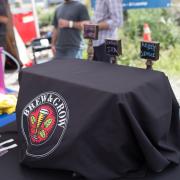http://www.breweryhistory.com/journal/archive/135/BrewersTales.pdf
http://www.greydragon.org/library/hops.html
http://www.pbm.com/~lindahl/scum/bottle.html
http://www.pbm.com/~lindahl/brewing.html
Had a little time to poke around and do some reading the past few days and the historical aspects of beer interest me quite a bit. Thought I'd share a few of the more surprising facts I've dug up over the past few days and my sources.
Ale vs. beer was a controversial thing around the 1200's Ale was made from the runnings of the mash, which presumably had the gruit (flavoring spices and NOT hops) in the mash. It was not boiled again, they just took the first runnings of the mash and added the yeast. It generally didn't keep for very long although some contemporary sources talk about it being kept fresh in bottles for up to a year. Beer on the other hand required more equipment to make because they would boil the mash runnings with hops then let it cool and pitch the yeast. Beer would reportedly keep for years in bottles and kegs.
Ale brewers were strictly prohibited from brewing beer and beer brewers were strictly forbidden from brewing ale.
The most saught after malts were the least smokey tasting, usually by malting with a straw fire as opposed to wood. In the case study of southhampton there's several references to contemporary medieval writers talking about how beer in the west of england was terrible because it was so smokey and only the locals and the unfortunate would drink their beer.
Beer has been bottled since around at least the 1300's
Medieval palates LOVED hops, the tastes eventually changed to a preference to a sweeter less hoppy beer but there is evidence that medieval hopping rates were up to 5 lbs of hops per barrel, a medieval barrel was 35 gallons, so in homebrew that's about a pound of hops for a seven gallon batch. The alpha acids of these medieval hops are unknown, but they would definitely be lower, probably similar to modern noble hop varieties.
In both medieval England and Germany it was not uncommon for there to be a bar per capita ratio of 1:12, and we think theres a lot of craft breweries popping up now...
For unknown reasons, and a trend that persists to this day, breweries have been forbidden to sell beer directly except for carryouts, there's evidence you could go down and get a growler filled 600 years ago. Our three tier distributorship has a solid basis dating back hundreds of years. There's speculation that this was started to give the middle class and lower classes an opportunity to open pubs and inns and make livings for themselves instead of giving the brewers too much power.
Brewers were making yeast starts at least 500 years ago.
Here's most of the sources in which I found those tidbits. The first link, the case study of South Hampton was particularly interesting.









http://home.comcast.net/~beerlabel/chic.htm
http://home.comcast.net/~beerlabel/chic9.htm
Here's some of our very own brewing history.
http://home.comcast.net/~beerlabel/chic9_files/chicweiss.htm
Apparently the Berliner Wiess Style had a pretty significant following here as well until the first world war and the anti-german sentiment kicked in.
http://forgottenchicago.com/articles/bygone-breweries/
http://www.timeoutchicago.com/things-to-do/this-week-in-chicago/7543049/...’-can-collection-reveals-chicago-brewery-history
http://forgottenchicago.com/articles/schoenhofen-brewery/